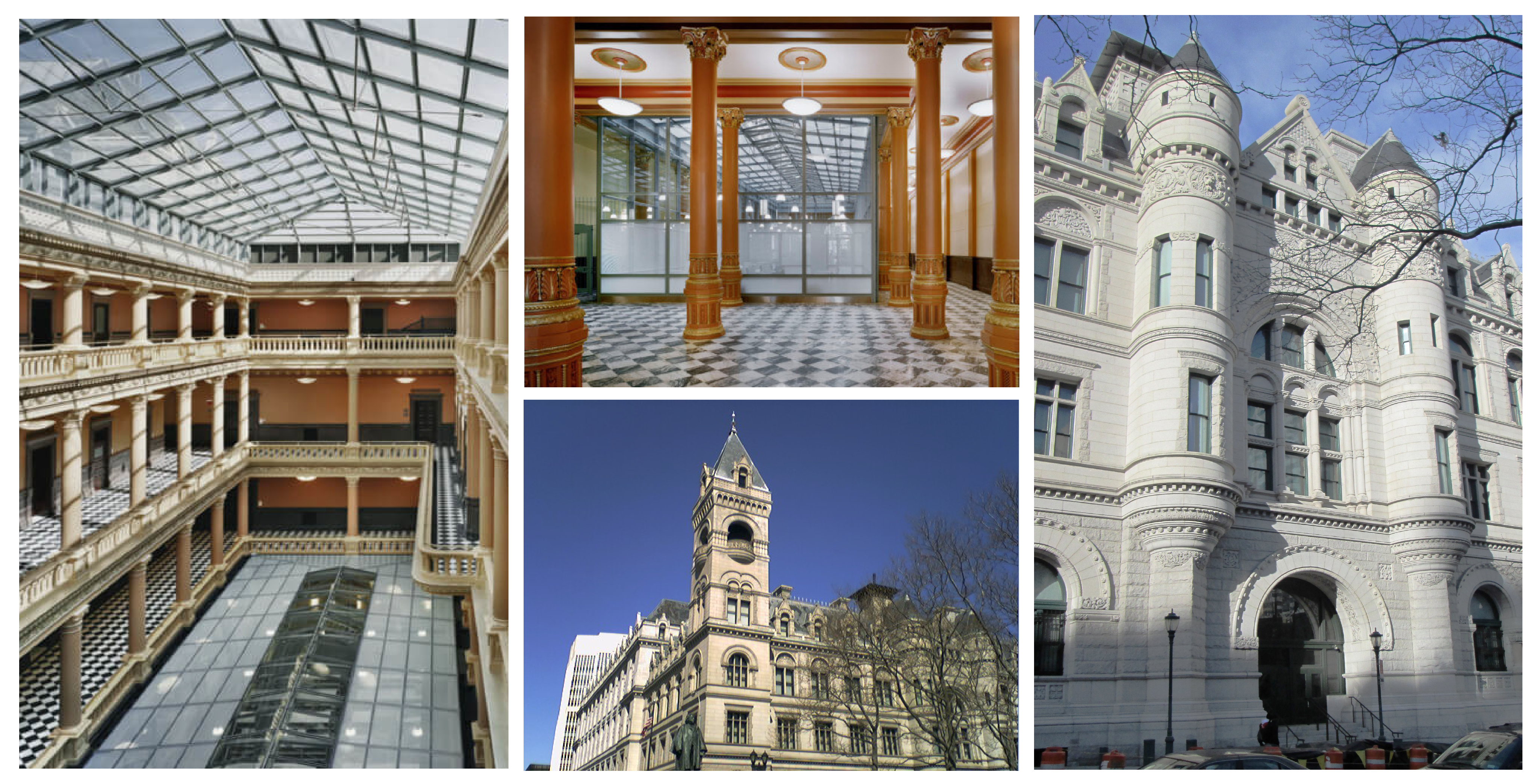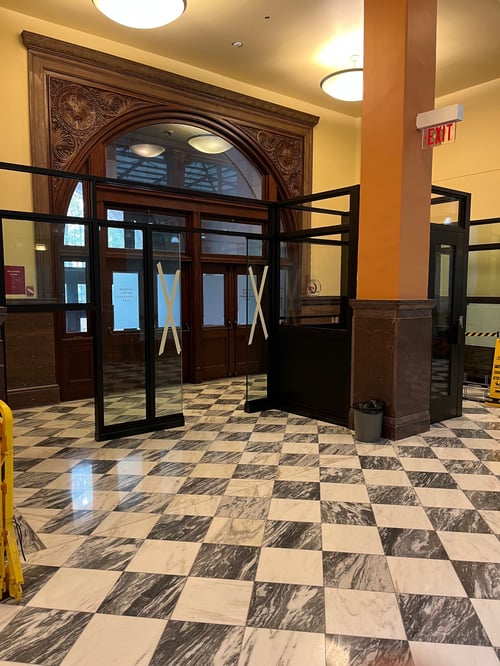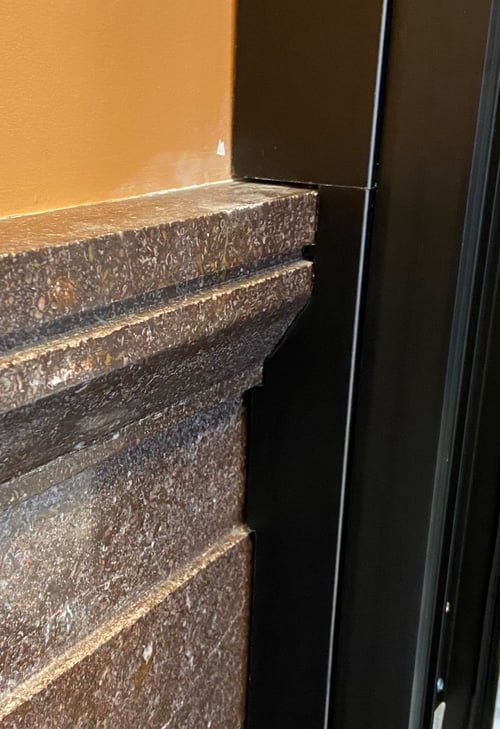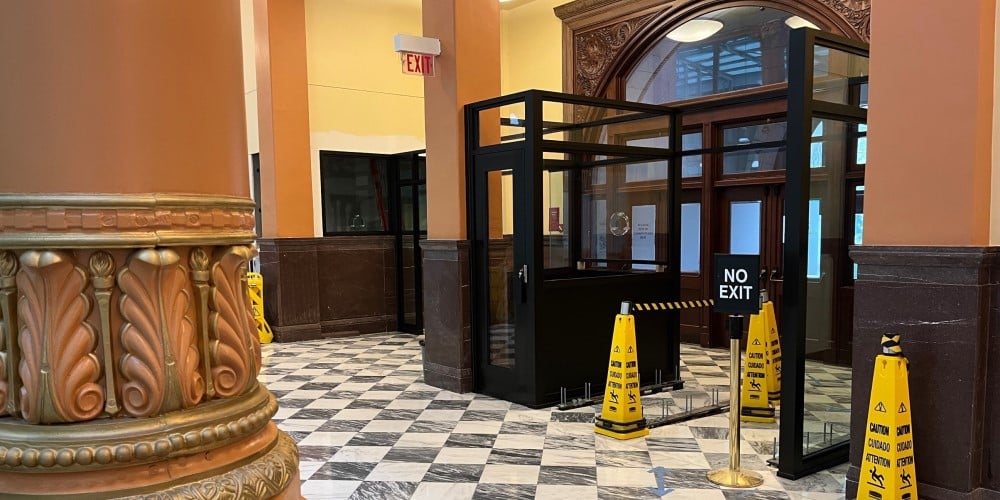The Conrad B. Duberstein US Bankruptcy Courthouse is an impressive sight. Located in the heart of Brooklyn, New York, the federal building and post office is a prime example of the Romanesque Revival style of architecture popular for public buildings—including government buildings, colleges, and houses of worship—in the late 19th Century. Romanesque Revival buildings are immediately recognizable for their rough brick or stone "castle/fortress" exteriors. They are often distinguished by steeply pitched hip roofs, heavy half-round arches around doorways and windows, and towers.
The Duberstein Courthouse ticks all the boxes: rough granite walls, a steeply pitched slate-covered mansard roof topped with ornamental ironwork cresting, elaborate dormers, half-round arches, and a picturesque tower. But it's most noted for its interior: ornate woodwork, soaring ceilings, a grand marble staircase, elegant columns and fixtures, mahogany Tennessee marble wainscoting, and floors tiled in diagonal black and white marble.

Like many historic government buildings, the old Brooklyn General Post Office and Courthouse faced a dilemma. On the one hand, it’s essential to preserve these gems, not just for their historic value, but also for their soaring aesthetic ideals. On the other hand, we need public buildings that are safe, secure, convenient, and highly functional on a daily basis.
History of Duberstein Courthouse
Planning and design for this building began in 1885. Originally much smaller, it was built to serve as a post office and four-room courthouse for Brooklyn (which was then still a small suburb). Construction was completed in 1891, the interiors finished the following year, and the building began serving the people shortly thereafter. The Brooklyn General Post Office and Courthouse was expanded to something approximating its current footprint in 1916, with several floors added to that expansion in 1933. It was finally added to the National Register of Historic Places in 1974.
Unfortunately, by then, the building had been marred by decades of poor maintenance and makeshift renovations and alterations. Thankfully, in 1999, the US General Services Administration (GSA) bought the building and embarked on intense renovations and restoration. A 2009 act of Congress ultimately renamed it the Conrad B. Duberstein United States Bankruptcy Courthouse. (Conrad B. Duberstein was a bankruptcy judge in the Eastern District of New York from 1973-1998.)
Today, the courthouse complex houses several courtrooms, a library, and a variety of administrative and legal offices for the US Postal Service, US Bankruptcy Court, the US Trustee, and the Offices of the US Attorney. It also serves as a public legal education resource, offering seminars and workshops on various topics related to bankruptcy law.
In 2019, the GSA began their latest round of renovations, aiming to preserve historic elements of the building while still improving the comfort and security of the building as a modern workplace and public institution. This included adding a ballistically secure checkpoint into a wide, high-traffic, historic entryway prominently located in the oldest portion of the building.
Challenges of bulletproof glass for historic buildings
This project came with three distinct sets of challenges.
First were logistics: this was a government-funded project that required cooperation among architects, government agencies, and a slew of contractors and trades. It was also in New York, the busiest and most densely populated city in the United States. And finally, given the nature of the building and its vital public services, the installation had to be completed quickly, with minimal disruption to building operations.
Next, it's a historic building. Adding bulletproof glass for historic buildings is especially challenging because you usually cannot change the size of door or window openings, move doorways, or even alter finishes. In this case, TSS needed to design a system that would mesh smoothly with ornate details on the walls. The system also had to be entirely freestanding: it could not anchor to walls or ceilings.
Finally, as the project commenced, they discovered an additional design and installation challenge: due to age and settling, the floor of the entryway was sloped significantly. This would not have been an issue with a smaller installation—like a small barrier or ballistic door. But given the size of the freestanding structure they needed, this presented significant challenges.
Bob Hoshaw was Total Security Solutions’ senior account representative for this project. He recalls, "there were a lot of design and engineering issues that we all had to work through. Dealing with everything that comes with working in a historic building was itself a difficult task, with occasional surprises. For example, I know Trevor [Smith, the project's installation manager] was out there and met with the clients onsite for the first field measurements. That's when we realized that the floor was running out on a significant slant from one end to the other. That would need to be addressed somehow."
Physical Security Upgrades: Solutions and Installation
The system TSS designed and installed for the courthouse consists of a ballistic curtain wall checkpoint that funnels all visitors through metal detectors. At the center of the wall is a dedicated guard booth for monitoring the entrance and scanners. Along the right side is a separate secured reception area and a security booth. The entire system is composed of GCP (glass-clad polycarbonate and held in place by ballistic aluminum framing.

"The shop was able to do a lot of custom prep work to the frames in order to speed up the installation process onsite," Trevor Smith notes. "This forethought into the project was greatly appreciated and very helpful. Although it was a relatively standard storefront system, it was still being installed in a historical building. This meant that we are unable to drill into the custom marble wainscoting on the walls. Members of our team did a great job measuring the details of that wainscoting so that the shop could create custom-scribed fillers to accommodate the stone. The wood shop and [steel shop] came together to make this engineering vision a reality."

In order to install this system on a slanted floor, TSS coordinated with the architects, contractors, and customers to create level "curbs" for the barrier to sit on—itself a novel engineering task—as well as the custom cladding to wrap the curbs prior to installation.
"They worked out perfectly," Trevor concludes. "The customer was astonished that we were able to create something so accurate and detailed that fit the situation so well."
TSS Brings It All Together
After the project was finished, Anton Levchenko, a Design-Build Project Manager for DCM Architecture & Engineering, noted that TSS "really cranked [this project] out—install top to bottom in one week. The scribing at the marble wainscot is impressive as well. … When all the effort that goes into coordination comes together and a talented team of installers comes on site with everything bit and bob they need, it really demonstrates how things are supposed to be done. … We will definitely be looking to you for any future ballistic work."
TSS CEO Jim Richards is, of course, happy to hear compliments. But, more importantly, he feels that the Duberstein Courthouse project represents everything that TSS aims to do well:
"A project like this really shows off what I like about our teams: precise and accurate measurements on site, good communication, having the right machines and the right people here in Fowlerville to fabricate pieces to that precision, and coordinating all of that so that a filler cut in mid-Michigan perfectly fits a 130-year-old piece of marble on a wall in Brooklyn. People ask if there was a lot of back and forth and trimming and shaving to get that fit just right, and the answer is 'No.' That’s because no one working on those pieces said 'Oh, that's good enough, that's close enough.' Everyone on our team is aligned on issues of safety and aesthetics. Everyone on the team makes it their business to make sure the fit is precise so that the system comes together smoothly, keeps people safe, and looks good.”
Are you embarking on physical security upgrades? Need custom ballistic barriers or bulletproof glass for historic buildings? Contact our ballistic security experts with any questions or to get started with a specific project today.

